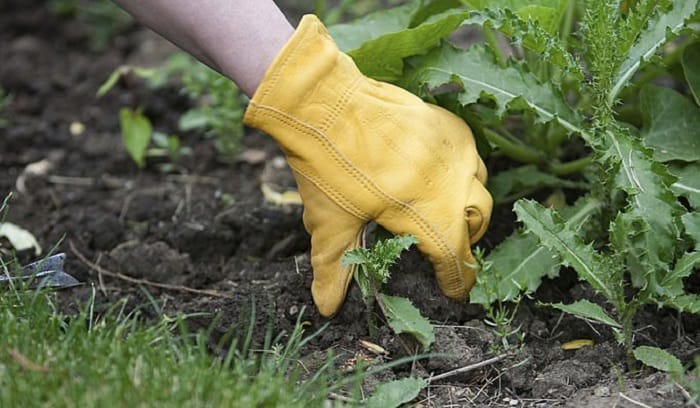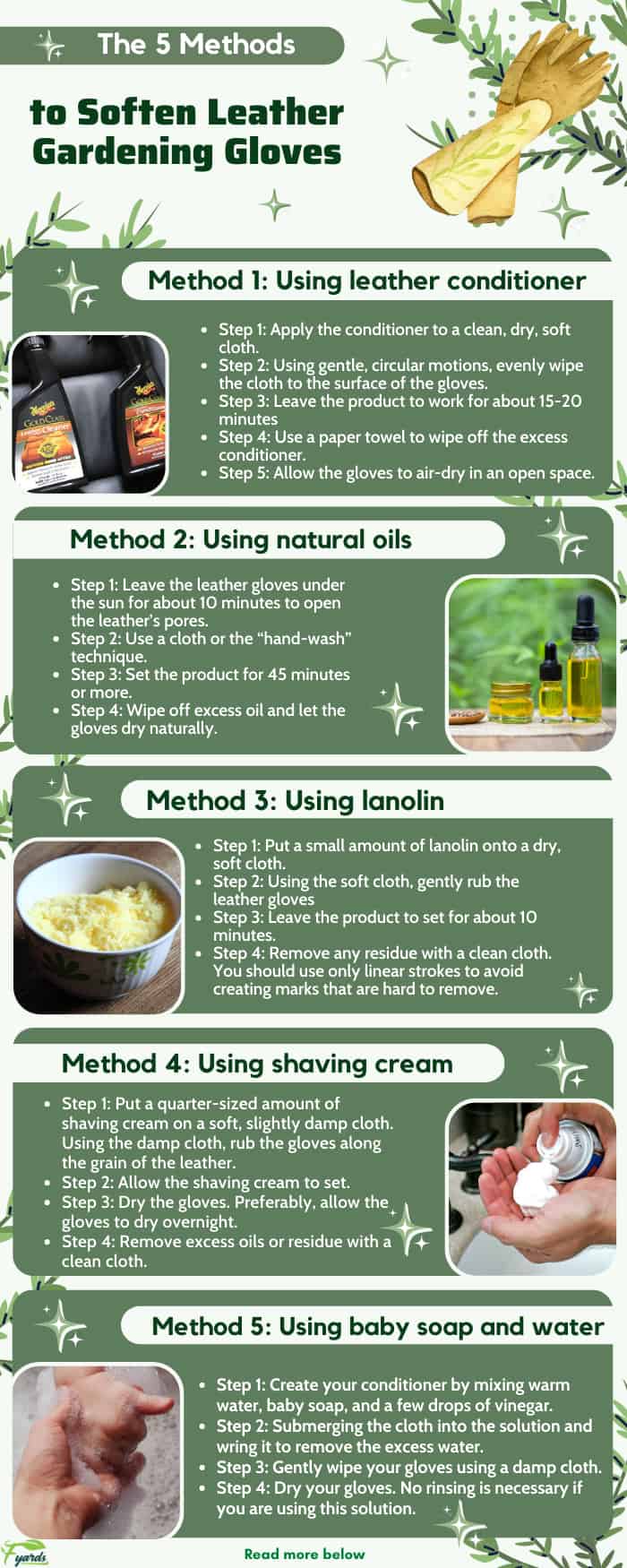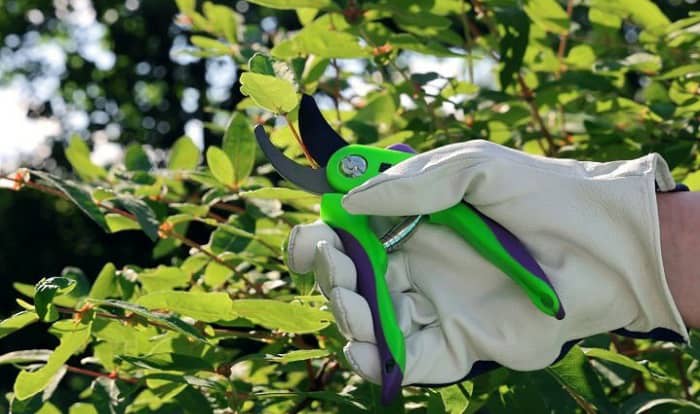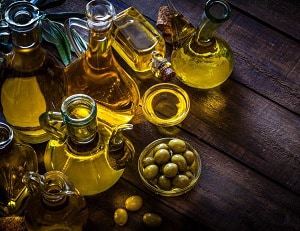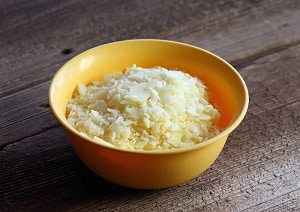Leather gardening gloves have long been used as protection from thorns, harmful chemicals, poisonous weeds, and other gardening threats.
Compared to other kinds of gloves, leather gardening gloves are sturdier and thicker, thus, providing excellent protection whilst ensuring that comfort is not compromised.
Made with goatskin, pigskin, or cowhide, leather gardening gloves require much care. Thus, extra steps are employed to clean and soften them, as they are prone to stiffening and cracking. But don’t worry, there are ways on how to soften leather gardening gloves.
Table of Contents
Different Ways to Soften Leather Gardening Gloves
Before applying any product, ensure that you have cleaned your gloves. Make sure you use leather-compatible cleaner to avoid ruining the fabrics.
Removing the accumulated dust and dirt allows your desired leather glove softener to adhere to the gloves properly.
Method 1: Using leather conditioner
Most leather conditioners are specially formulated to be easily absorbed by the leather’s fibers.
Therefore, using leather conditioner for gloves can keep them moisturized and conditioned not only on the surface but also deep in their textiles.
What you need for the task:
- A compatible and quality leather conditioner
- Some pieces of paper towels
- A clean and soft cloth
Here’s how you do it:
- Step 1: Apply the conditioner to a clean, dry, soft cloth. Avoid direct application onto the leather gloves to ensure an even spread and absorption.
- Step 2: Using gentle, circular motions, evenly wipe the cloth to the surface of the gloves.
- Step 3: Leave the product to work for about 15 minutes. You can leave it there for up to 20 minutes if your leather pair is too stiff to make a fist.
- Step 4: Next, use a paper towel to wipe off the excess conditioner. Do not over-wipe, as you might remove the product that has already penetrated the leather.
- Step 5: Allow the gloves to air-dry in an open space. During the drying process, wear the gloves from time to time to reshape and avoid the shrinkage of the gloves.
Method 2: Using natural oils
Natural oils can also be used to soften stiff leather gloves. Using oil for leather gloves is a cheaper alternative to leather conditioners, yet nourishing the fabric well.
What you’ll need:
- Natural oil of your choice (such as coconut oil, jojoba oil, almond oil, olive oil, and avocado oil, etc)
- Damp cloth
Simple steps to follow:
- Step 1: Since natural oils are not specially formulated to easily penetrate the skin, leave the leather gloves under the sun for about 10 minutes to open the leather’s pores.
- Step 2: You may use a cloth or the “hand-wash” technique.
-
- If using a cloth, put a liberal amount of oil on a damp cloth before wiping it on the leather glove.
- For the “hand-wash” technique, wear gloves, apply a generous amount of oil to one glove, and rub the gloves together.
Make sure to evenly distribute the product to damage-prone areas, such as the palm and the fingers.
- Step 3: Set the product for 45 minutes or more. In this step, the glove’s thickness must be considered. Thicker gloves may need more time to absorb the oil.
- Step 4: Wipe off excess oil and let the gloves dry naturally.
Method 3: Using lanolin
Lanolin is a wax mainly produced from sheep wool. Also known as wool wax or grease, lanolin is another substance used in treating leather, including leather gardening gloves.
It is applicable to soften goatskin gloves as it can replicate the natural oil usually found in goatskin.
You’ll need:
- Lanolin
- Dry, soft cloth (for application)
- Clean cloth (for residue removal)
Follow these steps to soften your gloves with lanolin:
- Step 1: Put a small amount of lanolin onto a dry, soft cloth.
- Step 2: Using the soft cloth, gently rub the leather gloves to ensure that the substance is well-distributed.
- Step 3: Leave the product to set for about 10 minutes.
- Step 4: Remove any residue with a clean cloth. You should use only linear strokes to avoid creating marks that are hard to remove.
Method 4: Using shaving cream
Together with natural oils, you may already have a can of shaving cream lying around at home. You may wonder why, but shaving cream is actually good for softening leather gloves.
Its ingredients include lanolin, glycerin, and other moisturizing agents that work on leather gardening gloves.
Materials needed:
- Shaving cream
- Damp cloth
- Extra clean cloth (for residue removal)
Here are the steps in using shaving cream:
- Step 1: Apply the shaving cream. Put a quarter-sized amount of shaving cream on a soft, slightly damp cloth. Using the damp cloth, rub the gloves along the grain of the leather.
- Step 2: Allow the shaving cream to set. If the leather is not soft enough for your preference, you may add more shaving cream until you get your desired softness.
- Step 3: Dry the gloves. Preferably, allow the gloves to dry overnight.
- Step 4: Remove excess oils or residue with a clean cloth.
Method 5: Using baby soap and water
If you don’t want to spend a lot of money on commercial leather glove softeners or waste any of your shaving cream, you can make a DIY leather glove conditioner using only baby soap and water.
Unlike beauty and bath soaps, baby soaps contain natural oils and other gentle and nourishing ingredients to the leather.
What you’ll need:
- Basin, or any mixing container.
- Water
- Vinegar
- Baby soap
- Microfiber cloth
To use baby soap to soften stiff leather gloves, follow these steps:
- Step 1: Create your conditioner by mixing warm water, baby soap, and a few drops of vinegar.
- Step 2: Dampen a piece of microfiber cloth using the solution. You can do this by submerging the cloth into the solution and wring it to remove the excess water.
- Step 3: Gently wipe your gloves using a damp cloth.
- Step 4: Dry your gloves. Please note that no rinsing is necessary if you are using this solution.
Helpful Tips
- Do not treat your leather gardening gloves too much, as it can compromise the leather’s durability.
- Always air-dry your gloves. Do not expose them directly to any heat source other than indirect sunlight to prevent them from drying out and cracking.
- To avoid shrinkage and retain the shape of the gloves, wear them from time to time as they dry out.
Conclusion
Softening leather gloves can be very intimidating at first, especially when you don’t know how to do it. Luckily, it is easy to do, there are various methods of how to soften leather gardening gloves.
Whether you’re using a commercial leather conditioner or a product you just found at home, your hands will appreciate softened gardening gloves rather than stiff ones.
Read more other gardening tips and tricks:
- The location of winter garden Florida.
- Tips to get rid of gnats with dawn dish soap.
- How to tell when potatoes are ready to harvest?

Hi, I am William – Floridayards’ digital content creator. My job is to find answers to all your concerns with thorough research and our team’s expert advice. I will also bring you honest reviews on the best products and equipment for raising your beautiful garden. Please look forward to our work!


